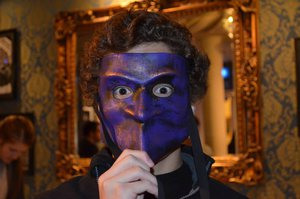Advertisement
Published: January 29th 2015

 Mask class
Mask class
Ari with his finished product.Today we learned a bit about the vast history of mask and mask-making in Venice. The tradition of mask wearing (and thus making) goes back to the 13th century. Masks were worn frequently to hide identity, thus giving a sort of social mobility, as well as opportunity to flirt with anyone, with impunity. Typically, men wore the "bauta" or white mask with a long nose. Combined with a cape, this gave the wearer total coverage--and total anonymity. Women went fairly uncovered body-wise, but wore black masks covering their entire faces and held in the teeth, disabling speech. This anonymity was important for flirting and sexual liasoning, most particularly during Carnevale, when partying was rampant. Masking was never allowed during Lent or on religious holidays.
After hearing about this bit of history, we decorated our own masks, using painting techniques taught by the wonderful staff at Teatro San Gallo. We will be wearing these when Carnevale ramps up in about a week. We have taken photos to incriminate ourselves ahead of time!
While masks are used recreationally and for artistic expression in Venice, Dean stumbled across a contemporary and very compelling use of mask-making on this very day.

 Mask Class
Mask Class
Our instructor, Sarah, shows us an example of the classic "bauta" mask with costume.See how mask-making is helping vets with PTSD express their experiences through this compelling piece in National Geographic:
Healing Soldiers · National Geographic
Advertisement
Tot: 0.053s; Tpl: 0.009s; cc: 6; qc: 24; dbt: 0.0244s; 1; m:domysql w:travelblog (10.17.0.13); sld: 1;
; mem: 1mb

 Mask class
Mask class
 Mask Class
Mask Class

nancy Streblow
non-member comment
A+
Very enjoyable, Adrienne.